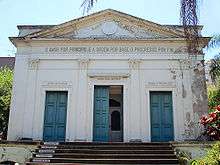Church of Humanity


Church of Humanity was a positivist church in England influenced and inspired by Auguste Comte's religion of humanity in France. It also had a branch or variant in New York City. Richard Congreve of the London Positivist Society was important to the founding of the English church in 1878.[1] Despite being relatively small the church had several notable members and ex-members. For example, Anna Haycraft was raised in the "Church of Humanity" before converting to Catholicism.
The New York City version originates with English immigrant Henry Edger. In 1854 he decided to dedicate himself to the "positive faith", but actual organization of the movement did not come for another decade. In 1869 an organization formed with David Goodman Croly as a leading member. Croly strongly believed in the religious element of Comtism, but was somewhat limited in evangelizing for it. By the 1870s the positivist organization led to an American version of the "Church of Humanity." This was largely modeled on the English church. Like the English version it wasn't atheistic and had sermons and sacramental rites.[2] At times the services included readings from conventional religious works like the Book of Isaiah.[3] It was not as significant as the church in England, but did include several educated people unrelated to Croly.[4] Nevertheless, one of the most noted people raised and baptized in the New York "Church of Humanity" was David Croly's son Herbert Croly.[5]
Temples of Humanity
- Chapelle de l’Humanité — 5 rue Payenne, Distrikt Le Marais, Paris
- Templo da Humanidade — Rua Benjamin Constant 74, Rio de Janeiro, Brasil
- Capela Positivista — Avenida João Pessoa 1058, Porto Alegre, Brasil
- Capela Positivista — Rua Riachuelo 90, Curitiba, Brasil
References
- ↑ Nineteenth-century English Religious Traditions: Retrospect and Prospect By Denis G. Paz
- ↑ For the Union of Evangelical Christendom: The Irony of the Reformed ... By Allen C. Guelzo: Chapter 2 "The Church of Humanity
- ↑ New York Times: January 16, 1881
- ↑ "The Church of Humanity": New York's Worshipping Positivists American Society of Church History.
- ↑ New York Review of Books
Print reference
- A Crusade for Humanity: The History of Organized Positivism in England... By John Edwin McGee
See also
- Religion of Humanity - In France and Brazil, possibly more directly from Comte.